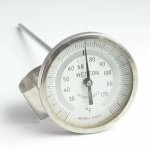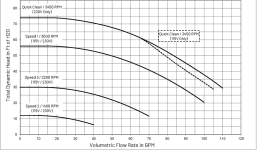Coordinating VSP Filter Pump with Heat Pump Heater
- Thread starter burgerchef
- Start date
You are using an out of date browser. It may not display this or other websites correctly.
You should upgrade or use an alternative browser.
You should upgrade or use an alternative browser.
- May 3, 2007
- 18,097
- Pool Size
- 20000
- Surface
- Plaster
- Chlorine
- Salt Water Generator
- SWG Type
- Hayward Aqua Rite (T-15)
If the bucket is cooler than the water, the bucket will remove heat from the water so it needs to run and overflow a while before it would stabilize. Also, the path from the heater to the return will also lose some heat. Ideally, you want to measure as close to the heater as possible but I know it may not be feasible.James, you asked me to post temp differences at various speeds. I will do that today or tomorrow. Unless you tell me otherwise I will do it this way... select maybe three RPMs, at each one I'll note the reading on the heater for the temp coming in to the heater, then run water directly out of the return into a bucket and read the temp.
I have a temperature probe right after the filter and in the SWG which is right after my heater so I can get fairly accurate temperature differences. However, the temperature readings are rounded to the nearest 1F so some accuracy is lost there as well.
The filter pressure head calculations and the full head calculations both are coming up with values close to 80 GPM at full speed so I would just go with that.
I would mostly close the main drain so that you get better action on the skimmers.
That will slightly change the system curve but not enough to really worry about.
As long as the temp rise is 6 degrees or less, the flow is fine.
That will slightly change the system curve but not enough to really worry about.
As long as the temp rise is 6 degrees or less, the flow is fine.
For a 400,000 btu gas heater, the temp rise can be up to about 16.8 degrees, so a 1 or 2 degree inaccuracy won't have as much effect on calculating flow as compared to a heater with 1/3 the heat output.
A 1 or 2 degree inaccuracy for a heat pump is like a 3 to 6 degree inaccuracy for a gas heater.
A 1 or 2 degree inaccuracy for a heat pump is like a 3 to 6 degree inaccuracy for a gas heater.
- May 3, 2007
- 18,097
- Pool Size
- 20000
- Surface
- Plaster
- Chlorine
- Salt Water Generator
- SWG Type
- Hayward Aqua Rite (T-15)
True but I also use the temperature difference for my solar, actually more often than the NG heater, which is about 3F rise.
For a 3 degree rise, you need to be pretty confident in the accuracy/resolution of the sensors.
If the sensors are +/- 1 degree, then the difference can be up to 2 degrees.
I would think that you would need an accuracy/resolution of about +/- 0.1 degrees to be reasonably certain about the flow.
If the sensors are +/- 1 degree, then the difference can be up to 2 degrees.
I would think that you would need an accuracy/resolution of about +/- 0.1 degrees to be reasonably certain about the flow.
So with my system, and assuming decent accuracy, is 1.5 to 3 degrees normal between 2400 and 3400? Would it be higher if I use, say 1,500?
So with my system, and assuming decent accuracy, is 1.5 to 3 degrees normal between 2400 and 3400?
Lower speeds should result in higher temperature rise because you are putting a fixed amount of heat into fewer and fewer gallons as the flow is reduced.Would it be higher if I use, say 1,500?
The temp rise approaches infinity as the flow rate approaches 0.
Below is the temp rise (Y-axis) vs. Flow in GPM (X-axis).
Based on our estimate, you are getting 80 GPM at 3,450 RPM, which should be 3 degrees.
At 1,725 RPM, you should be getting about 40 GPM, which should be about 6 degrees of temp rise.
Anything over 1,725 RPM should be sufficient unless the system curve changes like if the filter gets dirty or you close the main drain etc.
In my opinion, about 2,000 to 2,200 RPM is plenty to assure good flow with a decent margin to account for system curve changes.
2,200 RPM should be about 51 GPM with a clean filter.
You can install a flow switch in the plumbing if you are really concerned about inadequate flow.
A flow switch prevents the heater from operating with low flow.
You can also get a flow meter or two if you really feel like you need to know the flow to a high degree of certainty.


Last edited:
I got lucky...now I need help adding a flow switch
Evening, TFP World! We have an autocover that stays closed except when the pool is in use or needs to be left open to breath. Today, it was a beautiful day, so I left it open most of the day. I did not appreciate how much Crud was coming off the trees, and allowed both skimmer baskets to get...
Based on these numbers, I think that the temperature sensors are not accurate or the heater is significantly underperforming.2400 RPM - 82 to 85 - 3
2800 RPM - 78 to 80 - 2
3000 RPM - 80 to 81.5 - 1.5
3400 RPM - 79 to 80- 1
At full speed, the temp rise should be about 3 degrees.
You are getting 1 degree, which indicates a 2 degree error or the heater is only producing 1/3rd of the expected heat output or some combination of both.
At 120,000 btu/hr, the pool should gain about 0.496 degrees per hour.
However, you also have a loss rate, which depends on multiple variables and the loss rate can equal the gain rate for an uncovered pool, so this can be highly unreliable.
As the water temperature increases, the loss rate increases and the loss rate will eventually equal the gain rate and the temperature will remain stable in a dynamic equilibrium.
The temp rise for the whole pool is most accurate as you begin to heat the pool and the accuracy drops as the loss rate increases.
For example, if the pool loses 138 btu/sqft per hour at 800 square feet, then that is a loss of 110,400 btu/hr, which is about the performance of the heat pump at 80 F Ambient temperature, 63% Relative humidity and 80 F Water temperature.
(80/80/80 – AHRI) =120,000 btu/hr. 54 gpm.
(80/63/80 – AHRI) = 111,000 btu/hr. 50 gpm
(50/63/80 – AHRI) = 77,000 btu/hr. 35 gpm.
Ambient temperature (oF) / Relative humidity (%) / Water temperature (oF).

HEAT LOSS FROM WATER SURFACE AT VARIOUS AIR AND WATER TEMPERATURES AND AIR VELOCITIES AT 70% HUMIDITY.
Last edited:
- May 3, 2007
- 18,097
- Pool Size
- 20000
- Surface
- Plaster
- Chlorine
- Salt Water Generator
- SWG Type
- Hayward Aqua Rite (T-15)
If you don't want to do the math yourself, here is a spreadsheet where you can enter the information about your pool, location, date, plus dozens of other factors to estimate the heat loss and heat gain of the pool and how much energy your heat pump will use.
I populated it with your location (guessed), yesterdays temperatures, your heat pump performance at yesterdays temperatures in addition to many other default values for a typical pool.
The heat pump performance in lines 223-232 columns H & I depending on if you use a pool cover or not.

 docs.google.com
docs.google.com
I populated it with your location (guessed), yesterdays temperatures, your heat pump performance at yesterdays temperatures in addition to many other default values for a typical pool.
The heat pump performance in lines 223-232 columns H & I depending on if you use a pool cover or not.
Pool Heat Transfer Tools v024 - burgerchef
Last edited:
I'll wade through the latest info. For now I clearly see that to get more accurate I need to install one or more gauges.
I just now did the following measurements with what I have.
RPM - 2800
PSI - 10.5
Pool Water Temp - 78 on Heater Screen, 77 on Thermometer in pool water at skimmer (no sun on water there yet)
Return Water Temp - 80 on Thermometer - water run from 3' hose jammed tight over return into bucket

I just now did the following measurements with what I have.
RPM - 2800
PSI - 10.5
Pool Water Temp - 78 on Heater Screen, 77 on Thermometer in pool water at skimmer (no sun on water there yet)
Return Water Temp - 80 on Thermometer - water run from 3' hose jammed tight over return into bucket

James, my pool was installed in 2001. Around 2008 I noticed DE around the pool bottom drain, looked into it and changed the filter's check valve, it went smoothly. Last year I bought an entire new filter just for the finger nest... so I have an extra unused check valve and its elbow, (as well as a pressure gauge). So early this season when the tank was empty I figured I may as well be proactive and put in the new check valve. Forget about it. I then carefully read a TFP discussion on difficult elbow removal that I now realize you played the prominent role. I'm avoiding going in from the outside, so I'm in the same boat as the OP. If I recall correctly you eventually mentioned trying a plastic-safe penetrant, but the Op said it didn't work for him. I'm going to try that tomorrow. I'll let you know. When I try to wiggle the elbow as hard as I can without jerking the filter body around, I don't see movement, but do hear a little grating sound, so I am optimistic. I was able refresh my memory on exactly how to remove and install one since I have a spare and unused filter body with elbow and valve. When everything is new it practically jumps out on its own.
- May 3, 2007
- 18,097
- Pool Size
- 20000
- Surface
- Plaster
- Chlorine
- Salt Water Generator
- SWG Type
- Hayward Aqua Rite (T-15)
Is your concern here that the HP is not producing as much heat as it should? What is your goal here?I'll wade through the latest info. For now I clearly see that to get more accurate I need to install one or more gauges.
I just now did the following measurements with what I have.
RPM - 2800
PSI - 10.5
Pool Water Temp - 78 on Heater Screen, 77 on Thermometer in pool water at skimmer (no sun on water there yet)
Return Water Temp - 80 on Thermometer - water run from 3' hose jammed tight over return into bucket
Thanks - good question at the right time. Short answer, yes I am now thinking about that.
My first concern was I thought my filter pump could not supply the heater with GPM to satisfy the heaters spec'd ideal operating conditions. You guys have showed me that I don't have a problem there. I really appreciate the calculations, I now have the probable system curve of my setup, I understand the basics of it. The more I review all your input, the more I learn. Then recently in our back and forth, we started to discuss HP incoming and outgoing temp differences. Correct technical processes aside, I regularly hold one hand at the return and the other about two feet away. The feeling I get is simply the perceived level of difference. Its always noticeable, sometimes it seems significant, other times its a very slight difference. All I know from that is that it varies. Numerous times I tried measurements and posted that here. Some response postings here has made me wonder if my test method is flawed or if the HP is not up to snuff.
My first concern was I thought my filter pump could not supply the heater with GPM to satisfy the heaters spec'd ideal operating conditions. You guys have showed me that I don't have a problem there. I really appreciate the calculations, I now have the probable system curve of my setup, I understand the basics of it. The more I review all your input, the more I learn. Then recently in our back and forth, we started to discuss HP incoming and outgoing temp differences. Correct technical processes aside, I regularly hold one hand at the return and the other about two feet away. The feeling I get is simply the perceived level of difference. Its always noticeable, sometimes it seems significant, other times its a very slight difference. All I know from that is that it varies. Numerous times I tried measurements and posted that here. Some response postings here has made me wonder if my test method is flawed or if the HP is not up to snuff.
- May 3, 2007
- 18,097
- Pool Size
- 20000
- Surface
- Plaster
- Chlorine
- Salt Water Generator
- SWG Type
- Hayward Aqua Rite (T-15)
As I mentioned in the above post, measuring temperature differences that far from the HP can be problematic and very inaccurate.If the bucket is cooler than the water, the bucket will remove heat from the water so it needs to run and overflow a while before it would stabilize. Also, the path from the heater to the return will also lose some heat. Ideally, you want to measure as close to the heater as possible but I know it may not be feasible.
The temperature response to the change in RPM is likely to be very slow and it may take several minutes or even 10s of minutes for everything to stabilize so if you take your measurements to soon, they will likely have a lot of error.
Unless you can measure the temperature right after the HP, I wouldn't bother.
You need to know the temperature immediately before and after the heater to about +/- 0.1 degree to have good confidence in the results.
Unless you can assess the accuracy of the sensors, then it is probably not very useful.
If you had a higher heat output, you might be able to use a +/- 0.5 degree accuracy sensor, but not for measuring 3 to 6 degrees.
Unless you can assess the accuracy of the sensors, then it is probably not very useful.
If you had a higher heat output, you might be able to use a +/- 0.5 degree accuracy sensor, but not for measuring 3 to 6 degrees.
As I mentioned, we benefit from satisfactory results from the HP. I very much appreciate the opportunity to get into some details with experts in order to understand a little about what's actually happening. You guys have helped considerably. Thanks!
Thread Status
Hello , This thread has been inactive for over 60 days. New postings here are unlikely to be seen or responded to by other members. For better visibility, consider Starting A New Thread.




